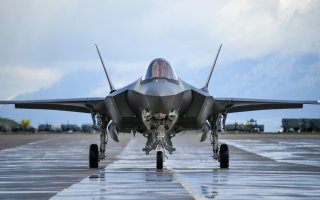Enemies Beware: America's F-35 Might Soon Track Ballistic Missiles
Weapons developers describe this technical advance in terms of something entirely compatible with ship-based Aegis radar.
The system hinges upon an upgraded ship-based radar and computer system referred to as Aegis Radar –- designed to provide defense against long-range incoming ballistic missiles from space as well as nearer-in threats such as anti-ship cruise missiles, he explained.
Developers said integrated air and missile defense provides an ability to defend against ballistic missiles in space while at the same time countering air threats to naval and joint forces close to the sea.
The NIFC-CA technology can, in concept, be used for both defensive and offensive operations, Navy officials have said. Having this capability could impact discussion about a Pentagon term referred to as Anti-Access/Area-Denial, wherein potential adversaries could use long-range weapons to threaten the U.S. military and prevent its ships from operating in certain areas -- such as closer to the coastline.
Having NIFC-CA could enable surface ships, for example, to operate more successfully closer to the shore of potential enemy coastines without being deterred by the threat of long-range missiles.
Defensive applications of NIFC-CA would involve detecting and knocking down an approaching enemy anti-ship missile, whereas offensive uses might include efforts to detect and strike high-value targets from farther distances than previous technologies could. The possibility for offensive use parallels with the Navy’s emerging “distributed lethality” strategy, wherein surface ships are increasingly being outfitted with new or upgraded weapons.
The new strategy hinges upon the realization that the U.S. Navy no longer enjoys the unchallenged maritime dominance it had during the post-Cold War years.
During the years following the collapse of the former Soviet Union, the U.S. Navy shifted its focus from possibly waging blue-water combat against a near-peer rival to focusing on things such as counter-terrorism, anti-piracy and Visit, Board Search and Seizure, or VBSS, techniques.
More recently, the Navy is again shifting its focus toward near-peer adversaries and seeking to arm its fleet of destroyers, cruisers and Littoral Combat Ships with upgraded or new weapons designed to increase its offensive fire power.
The current upgrades to the Arleigh Burke-class of destroyers can be seen as a part of this broader strategic equation.
The first new DDG 51 to receive Baseline 9 technology was the USS John Finn or DDG 113. The ship previously went through what’s called “light off” combat testing in preparation for operational use and deployment.
The very first Arleigh Burke-class destroyer, the USS Arleigh Burke or DDG 51, is now being retrofitted with these technological upgrades as well.
NIFC-CA technology is also being back-fitted onto earlier ships that were built with the core Aegis capability. This involves an extensive upgrade to combat systems with new equipment being delivered. This involves the integration of new cabling, computers, consoles and data distribution systems.
Existing destroyers and all follow-on destroyers will receive the Aegis Baseline 9 upgrade, which includes NIFC-CA and other enabling technologies. For example, Baseline 9 contains an upgraded computer system with common software components and processors, service officials said.
In addition, some future Arleigh Burke-class destroyers such as DDG 116 and follow-on ships will receive new electronic warfare technologies and a data multiplexing system which, among other things, controls a ship’s engines and air compressors, developers said.
The Navy’s current plan is to build 11 Flight IIA destroyers and then shift toward building new, Flight III Arleigh Burke-class destroyers with a new, massively more powerful radar system.
The new radar, called the SPY-6, is said by Navy officials to be 35-times more powerful than existing ship-based radar.
Flight III Arleigh Burke destroyers are slated to be operational by 2023.
This article first appeared in December 2017.
Image: U.S. Air Force photo by R. Nial Bradshaw

